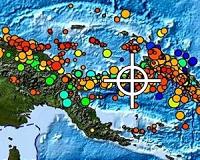| . |  |
. |
Edinburgh, UK (SPX) Aug 26, 2010 A better understanding of the ground beneath our feet will result from research by seismologists and Rapid-a group of computer scientists at the University of Edinburgh. The Earth's structure controls how earthquakes travel and the damage they can cause. A clear picture of this structure would be extremely valuable to earthquake planners, but it requires the analysis of huge amounts of data. The Rapid team developed a system that performs the seismologists' data-crunching, and have made it easy to use by relying on an interface familiar to all scientists - a web browser. Seismologists measure vibrations in the Earth at hundreds of observatories across Europe which allows them to study earthquakes as they travel across countries and continents. By measuring the speed and strength of the vibrations at different sites, deductions can be made about the type of ground they have travelled through. From this information, the structure of the Earth can be constructed. The problem with earthquakes is that they don't occur when and where you need them. Earthquakes aren't the only things that cause vibrations: road traffic, waves pounding on the beach and even wind and thunder can cause detectable vibrations. These vibrations - known as noise - may lack the strength of earthquakes, but they compensate by being available in huge numbers. If enough noise is analysed, it is possible to build up information about the Earth's structure. The analysis is not without problems; "You can use noise to analyse the Earth's structure, but you need to analyse huge amounts of data and that's nearly impossible on standard [computers]" explained Andreas Rietbrock, who helped develop the new system with the Rapid team and is Professor of Seismology at the University of Liverpool. The Orfeus foundation collects seismic data from around Europe and makes it available for analysis through websites like the Earthquake Data Portal (www.seismicportal.eu). Only a few organisations have the resources and technical know-how needed to process this vast store of data. Orfeus asked the Rapid team to develop a system that would allow any seismologist to analyse seismic data using powerful computers located around Europe. "We don't want [seismologists] to have to study how to access [remote] computer power and data" said Torild van Eck, Secretary General of Orfeus "Rapid is, for us, a tool to hide the tricky part of getting, steering and manipulating data". The Rapid team have developed a reputation for helping scientists use their data, and have worked with everyone from chemists to medics and biologists to engineers. "It's been great working with the seismologists, because as a community they're very open to trying out new ways of working. And they have really pushed the boundaries of our technology" said Jano van Hemert, leader of the Rapid team. For Orfeus, the team developed a web portal. This takes all the complex computing needed for seismic analysis and hides it behind a standard web browser. By presenting all of the analysis tools in such a familiar environment, any seismologist-even the most technophobic ones-can use the system. One of the first applications for the Rapid web portal is to allow seismologists to study noise for the analysis of the Earth's structure. Rapid will build on this work with help from a grant from the UK's Natural Environment Research Council, which has provided funding to explore whether it is possible to predict earthquakes and volcanic eruptions. The Rapid web portal allows even the smallest seismology groups to perform the kind of analysis that was previously limited to organisations that could afford their own supercomputers. By making this analysis easy, Rapid and Orfeus have brought complex research programmes into the hands of many more seismologists. More seismologists working together means that results are produced faster, and that means we could soon benefit from a better understanding of the ground beneath our feet.
Share This Article With Planet Earth
Related Links University of Edinburgh Bringing Order To A World Of Disasters When the Earth Quakes A world of storm and tempest
 Major 7.0-magnitude earthquake hits Papua New Guinea
Major 7.0-magnitude earthquake hits Papua New GuineaPort Moresby (AFP) Aug 5, 2010 A major 7.0-magnitude earthquake struck a remote mountainous region of the Pacific nation of Papua New Guinea on Thursday, seismologists said, causing panic but no initial damage or injuries. The quake hit a sparsely populated area of the island of New Britain at 8:01 am (2201 GMT Wednesday) at a depth of 54 kilometres, the US Geological Survey (USGS) and the Papua New Guinea Earthquake Offi ... read more |
|
| The content herein, unless otherwise known to be public domain, are Copyright 1995-2010 - SpaceDaily. AFP and UPI Wire Stories are copyright Agence France-Presse and United Press International. ESA Portal Reports are copyright European Space Agency. All NASA sourced material is public domain. Additional copyrights may apply in whole or part to other bona fide parties. Advertising does not imply endorsement,agreement or approval of any opinions, statements or information provided by SpaceDaily on any Web page published or hosted by SpaceDaily. Privacy Statement |